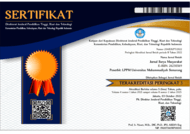Pendekatan Persuasif untuk Generasi Digital yang Terampil dan Produktif di Kampung Sukorame Mangunan Yogyakarta
(1) Widya Mataram University
(*) Corresponding Author
Abstract
The generation of digital natives has become a new term that is already quite popular in the ears of the public, especially for those who were born in the midst of the development of the internet and the digital world. Social media is even one of the products of the growth of digitalization which has been transformed as an alternative media with all its benefits. However, it cannot be denied, the existing phenomenon shows that users tend to ignore the ethics of media itself. So that a persuasive approach is needed, especially for those who are still very young, including the youth group in Kampung Sukorame Mangunan, Yogyakarta. This activity was attended by 20 participants consisting of youths aged 16-30 years with the aim that the group can become human resources capable of facing competition in the current creative industry. Using the lecture method, question and answer and direct practice, the participants are invited to be more productive with a number of discussion topics such as: interesting strategies in making curriculum vitae, creating podcast content as an alternative communication medium, as well as procedures for writing popular opinions that are packaged in such a way and delivered communicatively. possible. The results of the activity show that there is an urgency for the participants at the location because they have never received an approach as well as training, especially regarding digital literacy, which even most of the people interact with every day in the digital realm itself. This community service is expected to be a manifestation and serious effort in developing young people's soft skills in a sustainable digital era.
Keywords
Full Text:
PDFReferences
Bandura, A. (1986). Social Foudation of Thought and Action. Englewood Cliffs, NJ: Prentice-Hall.
Hootsuite and We Are Social. (2022). Digital 2022 Indonesia. https://andi.link/hootsuite-we-are-social-indonesian-digital-report-2022/. Diakses pada tanggal 20 Juni 2022.
Juditha, C. (2018). Hoax Communication Interactivity in Social Media and Anticipation (Interaksi Komunikasi Hoax di Media Sosial serta Antisipasinya). Pekommas, 3(1).
Instagram @pandusaka_org, Diakses pada tanggal 3 Januari 2022
Kementerian Komunikasi dan Informatika RI. (2021). Besok, Kominfo Luncurkan Program Literasi Digital Nasional “Makin Cakap Digital”. https://kominfo.go.id/content/detail/34574/siaran-pers-no-170hmkominfo052021-tentang-besok-kominfo-luncurkan-program-literasi-digital-nasional-makin-cakap-digital/0/siaran_pers. Diakses pada tanggal 23 Desember 2021
Ningrum, D. P. (2019). PEMANFAATAN MEDIA SOSIAL TERHADAP FENOMENA “HOAX” DI KALANGAN REMAJA MILENIAL (STUDI DI SMAN 1, KECAMATAN PLERET, BANTUL, YOGYAKARTA). Jurnal Ilmiah Padma Sri Kreshna, 1(1).
Nurudin. (2017). Ilmu Komunikasi: Ilmiah dan Populer. Jakarta: PT Raja Grafindo Persada.
Penerbit Buku Deepublish (2022). Karya Tulis Ilmiah Populer : Pengertian, Karakteristik, Hingga Contohnya. https://penerbitbukudeepublish.com/karya-tulis-ilmiah-populer/. Diakses pada tanggal 15 Juni 2022
Septarini, Dina Fitri. (2015). Pengaruh Pelayanan, Sanksi, dan Kesadaran Wajib Pajak Terhadap Kepatuhan Wajib Pajak Orang Pribadi Di KPP Pratama Merauke. Jurnal Ilmu Ekonomi dan Sosial Universitas Musamus Merauke, Vol. 6, No. 1, Hal. 29-43.
Article Metrics
Abstract view : 270 timesPDF - 87 times
DOI: https://doi.org/10.26714/jsm.5.1.2022.50-59
Refbacks
- There are currently no refbacks.
Copyright (c) 2022 Jurnal Surya Masyarakat

Jurnal Surya Masyarakat (JSM) is licensed under Creative Commons Attribution-NonCommercial-NoDerivatives 4.0
------------------------------------------------------------------------------------------------------------------------
Jurnal Surya Masyarakat (JSM)
p-ISSN: 2623-0364; e-ISSN: 2623-0569
Published by: Lembaga Penelitian dan Pengabdian Masyarakat (LPPM) Universitas Muhammadiyah Semarang



.jpg)







.jpg)